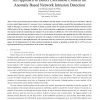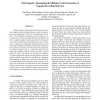33 search results - page 3 / 7 » N-Gram-Based Detection of New Malicious Code |
IPPS
2007
IEEE
14 years 2 months ago
2007
IEEE
Since current internet threats contain not only malicious codes like Trojan or worms, but also spyware and adware which do not have explicit illegal content, it is necessary to hav...
MATA
2004
Springer
14 years 1 months ago
2004
Springer
Mobile agents are software entities consisting of code, data and state that can migrate autonomously from host to host executing their code. Unfortunately, security issues restrict...
IEEEARES
2010
IEEE
14 years 1 months ago
2010
IEEE
Spyware represents a serious threat to confidentiality since it may result in loss of control over private data for computer users. This type of software might collect the data and...
ASPLOS
2011
ACM
13 years 4 days ago
2011
ACM
Kernel rootkits that modify operating system state to avoid detection are a dangerous threat to system security. This paper presents OSck, a system that discovers kernel rootkits ...
ACSAC
2006
IEEE
14 years 2 months ago
2006
IEEE
Modern malware often hide the malicious portion of their program code by making it appear as data at compiletime and transforming it back into executable code at runtime. This obf...


